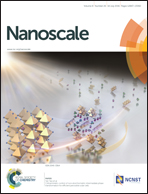A rational design for the separation of metallic and semiconducting single-walled carbon nanotubes using a magnetic field†
Abstract
The separation of metallic (m-) and semiconducting (s-) single-walled carbon nanotubes (SWNTs) without causing contamination and damage is a major challenge for SWNT-based devices. As a facile and nondestructive tool, the use of a magnetic field could be an ideal strategy to separate m-/s-SWNTs, based on the difference of magnetic susceptibilities. Here, we designed a novel magnetic field-assisted floating catalyst chemical vapor deposition system to separate m-/s-SWNTs. Briefly, m-SWNTs are attracted toward the magnetic pole, leaving s-SWNTs on the substrate. By using this strategy, s-SWNTs with a purity of 99% could be obtained, which is enough to construct high-performance transistors with a mobility of 230 cm2 V−1 s−1 and an on/off ratio of 106. We also established a model to quantitatively calculate the percentage of m-SWNTs on the substrate and this model shows a good match with the experimental data. Furthermore, our rational design also provides a new avenue for the growth of SWNTs with specific chirality and manipulated arrangement due to the difference of magnetic susceptibilities between different diameters, chiralities, and types.


 Please wait while we load your content...
Please wait while we load your content...